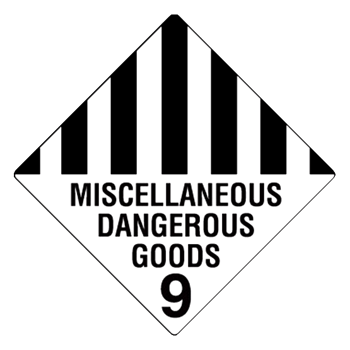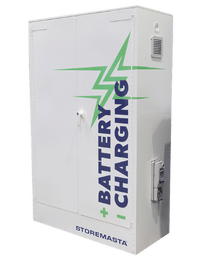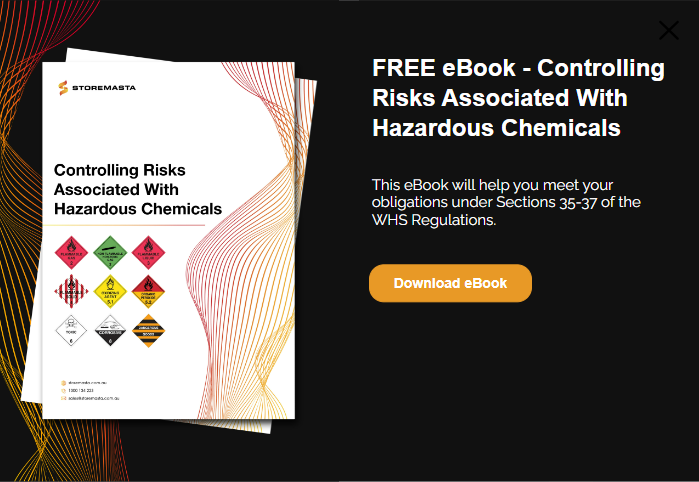Does your business carry any type of Class 9 Miscellaneous Dangerous Goods? You may be surprised to find out what commonly found articles and substances fall into this class of chemicals. Class 9 dangerous goods include items such as lithium-ion batteries, dry ice and even first aid kits. In this blog, we’ll be taking a closer look at this chemical class and explaining what you need to do to ensure safe, compliant Class 9 Miscellaneous Dangerous Goods storage.
What are Class 9 Dangerous Goods?
Within the 9 classes of dangerous goods, there are a variety of substances and articles which present a unique danger — not covered by Classes 1 to 8.
Class 9 Miscellaneous Dangerous Goods include a diverse range of articles and substances that you probably already carry and store in your own workplace.
Some examples of commonly found miscellaneous dangerous goods include:
- lithium-ion batteries
- battery-powered equipment
- asbestos products
- air bag inflators
- dry ice
- first aid kits
- some agricultural chemicals

There are a diverse range of articles and substances within the Class 9 dangerous goods category, including lithium-ion batteries.
While the applications for Class 9 DG are broad, these items are still considered hazardous and must be handled and stored in a compliant manner that reduces risk.
Referring to the Australian Standards
When working with any type of dangerous goods, it's imperative that you have guidelines, policies and procedures in place to ensure the safety of your business — and the wider community. When it comes to Class 9 Miscellaneous Dangerous Goods, the Australian Standards are a particularly useful resource that can help you meet your compliance obligations.
The Standard which relates to this chemical class, is AS NZS 4681:2000 – The storage and handling of Class 9 dangerous goods and articles.
You may refer to this standard to determine the requirements for minor and bulk storage, the location, design and construction of package stores, emergency management, fire protection, waste storage and disposal, and more.
This Standard does not apply to the follow situations which involve Class 9 DG. These include:
- Transport which is covered by other regulations
- Storage and handling of bitumen
- Storage and handling regulated only for air transport
- Handling of goods and articles in port areas
- Storage and handling on farms
- Genetically modified micro-organisms
For Class 9 goods that fall into these categories, other requirements and regulations do apply.
Storage of Class 9 Articles and Substances
Just like any class of Dangerous Goods, miscellaneous dangerous goods are subject to the requirements of WHS Regulations and the Australian Standards. While not law, the Standards do provide a detailed guide on how to apply the regulations to your workplace so you can achieve and maintain chemical compliance.
For storage of Class 9 Miscellaneous Dangerous Goods, we refer the Section 2 of AS NZS 4681:2000 which explains the criteria and conditions for minor storage. However, we must first look at the five storage groups which categorise various Class 9 goods.
Storage Groups
The storage groups detailed in the Standard are as per below:
Group 1: Environmentally hazardous substances
This group includes:
UN 3077 solids and or UN 3082 liquids - maximum quantity 1,000 kg/L, maximum quantity PG 1 100 kg/L
Agricultural chemicals – maximum quantity 10,000 kg/L, PG 1 maximum quantity 1,000
Group 2: Equipment containing small quantities of DG
UN 2990 and UN 3072, life saving appliances – no limit to maximum quantity
UN 3091, lithium batteries or equipment – no limit to maximum quantity
UN 3268, air bag inflators – no limit to maximum quantity
UN 3316, chemical or first aid kit – no limit to maximum quantity
 Class 9 Dangerous Goods are categorised into five groups for the purpose of determining their storage requirements.
Class 9 Dangerous Goods are categorised into five groups for the purpose of determining their storage requirements.
Group 3: Elevated temperature substances
UN 3257 liquids - maximum quantity 100 kg/L, no limit to maximum quantity of PG 1
UN 3258 solids - maximum quantity 1,000 kg/L, no limit to maximum quantity of PG 1
The maximum quantity that’s recognised as minor storage is 1,000 (kg/L)
Group 4: Specially controlled substances
UN 2212 or 2590 asbestos – not permitted
UN 2315 polychlorinated biphenyls – small items only
Group 5: Other Class 9 dangerous goods
UN 1845, Solid carbon dioxide (dry ice) - maximum quantity 1,000 kg/L, maximum quantity PG 1 100 kg/L
UN 2071, Ammonium nitrate fertilizer, N.O.S. - maximum quantity 1,000 kg/L, maximum quantity PG 1 100 kg/L
UN 2211, Polymeric beads, expandable - maximum quantity 1,000 kg/L, maximum quantity PG 1 100 kg/L
UN 3314, Plastics moulding compound - maximum quantity 1,000 kg/L, maximum quantity PG 1 100 kg/L
Minor Storage for Class 9 Miscellaneous Goods
If you refer to the above explanations for the group types of Class 9 goods, then you can determine if your miscellaneous goods meet the minor storage requirements.
Section 2.2 of the Standard explains the requirements that relate to the storage of Class 9 goods in the workplace:
(a) The quantity of Class 9 dangerous goods and articles stored shall not exceed one minor storage per 500 m2 floor or ground area. Where the area exceeds 500 m2, minor storages shall be at least 10 m apart.
(b) A minor storage of Group 3 shall be separated by at least 20 m from any other storage of elevated temperature dangerous goods.
(c) Class 9 dangerous goods of Groups 1, 2 and 5 may be kept together in the one minor storage. In such cases, the aggregate quantity shall not exceed 1000 kg or L, including not more than 100 kg or L of Class 9 PG I dangerous goods.
Minor Storage Conditions
Class 9 minor stores should be designed, constructed and maintained to reduce the risks associated with the articles or substances that they’re holding.
The Standard explains that there are multiple requirements for minor storage, including:
- Stores (other than those containing elevated temperature substances) must be away from naked flames and heat sources
- Adequate natural or mechanical ventilation, that’s appropriate to the type of goods and nature of the operation, must be provided
- Class 9 Packages shall only be opened in a well-ventilated area.
- Containers of Class 9 DG shall be kept closed when not in use.
- Storage and container types must avoid leakage or spillage.
- Appropriate spill containment shall be provided where packages are opened or goods are transferred.
- Stores must be kept clear of combustible matter and refuse
- Where appropriate, a supply of water must be available at a nearby location for personal hygiene
- Any staff who are handling the dangerous goods shall be fully informed of the hazards involved.
Package Stores for Class 9 Miscellaneous Dangerous Goods
If the quantities of your substances and articles exceeds those referenced as minor storage, then you may be subject to the requirements for Class 9 package stores.
The types of packages stores can be one of the following, or a combination of the following store types. These include:
- A storage cabinet
- Secure outdoor storage area
- Free-standing roofed structure or building
- A roofed structure or room, attached to an external wall of your building
- A room, ensure or area within your building
Due to the accessibility, practicality, convenience and safety features of a storage cabinet, they are often the preferred choice for businesses who carry Class 9 Miscellaneous Goods.
Class 9 Storage in Safety Cabinets
Section 3.3 of AS NZS 4681:2000 explains the design and construction requirements for Class 9 package stores. These requirements include:
- Stores to be designed and constructed so housekeeping can be effectively actioned
- Floors, wall and roof sheeting must be non-combustible and resistant to attack by the stored goods
- Floors should be designed and constructed so any molten chemicals, caused by a fire, are diverted into a suitably safe area for disposal
- Shelving should be designed and installed so residues can’t build up along ledges or in corners and spillage can be noticed and cleaned up
Battery Storage for Lithium-Ion Batteries
In addition to the recommendation of using compliant safety cabinets to store your dangerous goods, there are specific cabinets designed to reduce risk with your lithium-ion batteries.
As a product that’s recognised as Class 9 Miscellaneous Dangerous Goods, lithium-ion batteries pose a range of risks to the workplaces that handle and store them. The risks associated with lithium-ion batteries include thermal runaway, fire, explosion and human harm.
Add to this the sensitivity of the battery to elevated ambient temperatures, and you have an item which can create hazards in your workplace if it’s not handled and stored in the correct manner.
A battery cabinet will minimise the risk of fire, explosion and thermal runaway in your stores of lithium-ion batteries.
Battery storage has become an increasingly important aspect of dangerous goods management. Choosing a battery charging and storage cabinet can help you reduce the risk of overheating, overcharging, battery malfunctions and battery acid spills.
Battery cabinets provide a range of risk control measures including:
- Liquid-tight spill sump
- Close-fitting doors
- Non-combustible materials for cabinet construction
- Thermal air barrier within the walls
- Natural or mechanical ventilation systems
- Electrically certified power supply
By storing your Class 9 batteries in a battery cabinet, you’ll be providing a more secure, safe and temperature-controlled environment for your lithium-ion batteries.
How are You Storing Lithium-Ion Batteries and Class 9 DG?
Thanks for reading our blog detailing the minor and package store requirements for Class 9 Miscellaneous Dangerous Goods. As we’ve explained, this chemical class poses a unique set of risks not relevant to the other 8 classes of dangerous goods. When determining your storage needs, we highly recommend conducting a risk assessment. This will help you identify, assess, control and sustain any chemical hazards that are apparent in your workplace. If you’d like to find out more about dangerous goods storage and reducing your risks, we have an eBook that can help. Controlling Risks Associated With Hazardous Chemicals will introduce you to our risk control methodology so you can create a safer workplace and achieve chemical compliance. Grab your copy for free by clicking on the image below.
Joining the team as a Dangerous Goods Storage Consultant, Melissa Hampton became Storemasta's Marketing Manager in late 2021. With extensive knowledge and experience in chemical compliance, Melissa is responsible for leading the Marketing team and helping shape their marketing strategy. In her spare time, you can find Melissa hiking, swimming and enjoying the great outdoors in beautiful north-west Tasmania.

